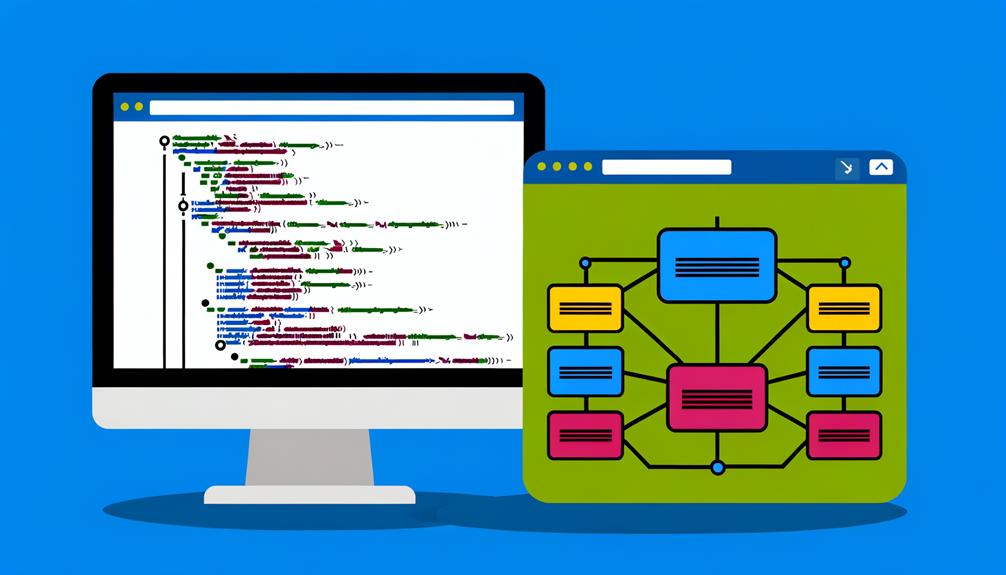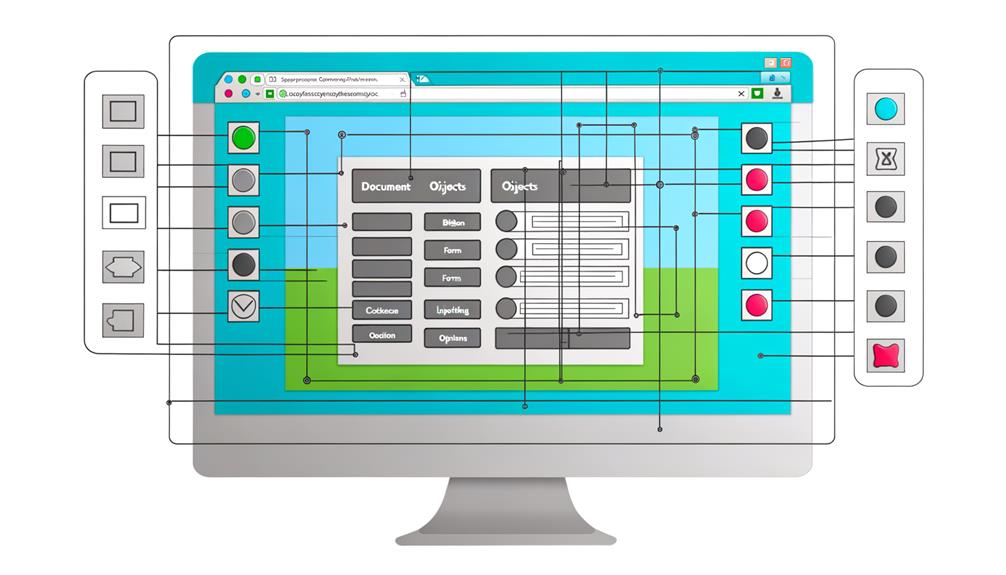They say 'knowledge is power,' and when it comes to the inner workings of the web, understanding the Document Object Model (DOM) is key. As non-programmers, we might not realize the pivotal role the DOM plays in shaping our online experiences.
But here's the thing – the DOM is not just relevant to developers. It's a fundamental concept that can empower us to understand, interact with, and even shape the digital landscape we navigate daily.
So, what exactly is the DOM? Stay tuned as we unravel the mystery behind this essential component of web technology and discover why it matters to all of us, regardless of our coding expertise.
What Is the Dom?

The DOM, or Document Object Model, is a crucial programming interface for HTML. It enables dynamic web pages and is a fundamental component for web development. The DOM translates HTML content into a standardized object that functional programming languages like JavaScript can access and modify.
Without the DOM, web pages would be static and boring. The DOM is essential for web development because it allows JavaScript to easily comprehend HTML and execute functions on individual HTML elements. Objects in the DOM provide easy access to specific data, enabling JavaScript to make changes to web pages in cool ways.
Understanding the DOM is crucial for liberation in web design and development. It empowers individuals to create dynamic, interactive, and engaging websites that captivate and liberate users.
Understanding the DOM
Understanding the DOM empowers individuals to create dynamic, interactive, and engaging websites that captivate and liberate users, allowing JavaScript to easily comprehend HTML and execute functions on individual HTML elements.
The DOM serves as a bridge between the static HTML content and the dynamic, responsive behavior of JavaScript. It provides a structured representation of the HTML document, enabling developers to manipulate the content, style, and structure of web pages.
By grasping the DOM, individuals gain the ability to access and modify specific elements within a web page, enabling them to create seamless and personalized user experiences.
This understanding is paramount for anyone seeking to break free from static, mundane websites and venture into the realm of dynamic, user-centric web development.
Importance of the DOM

Importance of the DOM can't be overstated in modern web development, as it serves as the backbone for dynamic and interactive user experiences.
The DOM, or Document Object Model, is crucial for creating responsive and engaging websites. It enables JavaScript to access, modify, and update the content, structure, and style of web pages in real time.
Without the DOM, the web would be static and lack the interactivity that users expect. By understanding the DOM, we gain the power to transform static HTML documents into dynamic, personalized experiences for users.
This knowledge liberates us to create websites that aren't only visually appealing but also highly functional, providing a rich and immersive user experience.
Embracing the significance of the DOM is essential for anyone seeking to excel in modern web development.
Role in Web Design
Embracing the significance of the DOM in modern web development liberates us to create dynamic and interactive user experiences. This importance is evident in its crucial role in web design.
JavaScript, empowered by the DOM, controls the behavior of web pages. It links JavaScript to the HTML code and enables the execution of functions on individual HTML elements. Objects in the DOM facilitate easy access to specific data, allowing JavaScript to target elements and make changes.
The DOM is central to modern websites, enabling JavaScript to alter web pages in innovative ways. Without the DOM, web pages would be static and uninteresting.
Understanding the DOM's role in web design is essential for creating engaging, interactive, and visually appealing web experiences. It empowers us to unleash the full potential of web development.
Significance in Web Development

The DOM plays a crucial role in modern web development, allowing for dynamic and interactive user experiences through its manipulation of HTML content using JavaScript. Its significance in web development is undeniable:
- Enhanced User Experience: The DOM enables seamless and responsive web interactions, elevating user satisfaction.
- Efficient Development: With the DOM, developers can create dynamic web pages more efficiently, saving time and effort.
- Empowerment of Web Design: The DOM empowers web designers to craft visually appealing and engaging websites with interactive elements.
- Flexibility and Adaptability: Through the DOM, web developers can easily adapt and modify web content, keeping it fresh and relevant.
Understanding the significance of the DOM is pivotal for liberating web development from static and mundane experiences, paving the way for innovative and captivating digital spaces.
DOM and HTML Interface
The significance of the DOM in modern web development becomes even more apparent when considering its seamless integration with the HTML interface. The DOM serves as a bridge between the structure of HTML and the functionality of JavaScript, enabling dynamic and interactive web experiences. Here's a comparison table to highlight the relationship between the DOM and the HTML interface:
| DOM | HTML Interface |
|---|---|
| Represents HTML as a single object | Defines the structure of web content |
| Organizes HTML information for JavaScript | Provides the content and layout of web pages |
| Allows JavaScript to easily comprehend HTML | Displays content and interacts with users |
| Enables JavaScript to make changes to the web page | Presents content in a visually appealing manner |
Understanding the seamless integration of the DOM with the HTML interface empowers individuals to create engaging and responsive web experiences.
Objects in the DOM

Objects in the DOM facilitate the organization and hierarchical structure of data within web pages, enabling efficient access and manipulation for dynamic user experiences.
Here's why understanding objects in the DOM is crucial:
- Data Organization: Objects organize related data, providing a logical and hierarchical structure.
- Hierarchical Representation: Objects can contain other objects, resembling trees with branches representing data.
- Linking JavaScript to HTML: The DOM represents an HTML document as a single object, allowing JavaScript to easily comprehend and manipulate HTML information.
- Easy Data Access: Objects in the DOM allow for easy access to specific data, enabling JavaScript to execute functions on individual HTML elements for dynamic web pages.
Understanding objects in the DOM is liberating, as it empowers individuals to create engaging and interactive web experiences.
JavaScript and the DOM
Discussing JavaScript and the DOM, we harness the power of dynamic web development through seamless interaction and manipulation of web page elements.
JavaScript, a versatile programming language, empowers us to dynamically modify the content and style of web pages. By utilizing the DOM, we can access and manipulate specific elements within the HTML document, enabling us to create interactive and engaging user experiences.
JavaScript's integration with the DOM allows for real-time updates and responses to user actions, leading to a more immersive browsing experience.
With JavaScript and the DOM, we've the freedom to create dynamic, responsive, and visually appealing web pages that captivate and engage users, ultimately revolutionizing the way we interact with the digital world.
Dynamic Web Pages

JavaScript and the DOM empower us to create dynamic web pages that captivate and engage users through seamless interaction and manipulation of web page elements. Dynamic web pages offer a more immersive and personalized user experience, and here's why they're essential for modern web development:
- Real-time updates: JavaScript and the DOM allow web pages to update content without requiring a full page reload, providing a smoother and more responsive experience.
- Interactive features: Dynamic web pages enable interactive elements such as pop-ups, sliders, and forms that respond to user input in real time.
- Personalization: Through dynamic content generation, web pages can deliver personalized recommendations and tailored user experiences.
- Enhanced user engagement: Dynamic web pages encourage increased user engagement through animations, dynamic layouts, and seamless transitions.
These features empower us to create web experiences that aren't only visually appealing but also highly functional and user-centric.
Debugging and Redesigning With the DOM
Debugging and redesigning web pages with the DOM requires a deep understanding of how the DOM interacts with JavaScript and HTML elements to identify and resolve issues effectively.
By utilizing the DOM, we gain the power to manipulate and modify the structure, style, and content of web pages. When faced with challenges, we can inspect and modify the DOM using browser developer tools to pinpoint and rectify issues swiftly.
The DOM empowers us to revamp and optimize web pages by dynamically altering their elements and attributes. Through this process, we liberate ourselves from static and mundane web designs, breathing new life into our creations.
Embracing the DOM not only enhances our debugging capabilities but also unleashes the full potential of our web development endeavors.
Frequently Asked Questions
How Does the DOM Impact the Loading Speed of a Web Page?
The DOM impacts the loading speed of a web page by allowing JavaScript to access and modify the document's structure and content.
JavaScript can use the DOM to dynamically manipulate page elements, leading to delays in rendering if not optimized.
Efficient DOM manipulation and minimizing unnecessary changes can improve loading speed.
Understanding how the DOM influences page loading is crucial for creating fast and responsive web experiences.
Can the DOM Be Accessed and Modified by Languages Other Than Javascript?
Yes, the DOM can be accessed and modified by languages other than JavaScript. We can use languages like Python, Ruby, and Java to interact with the DOM through specialized libraries and frameworks.
These languages enable us to manipulate HTML content and create dynamic web pages, expanding our options for web development and enhancing user experience.
Accessing the DOM with different languages empowers us to craft versatile and engaging websites.
How Does the DOM Handle Interactions With User Input on Web Pages?
The DOM handles interactions with user input on web pages by providing a structured representation of the HTML content. This allows JavaScript to easily access and modify elements in response to user actions.
This enables dynamic and responsive web page behavior, empowering developers to create engaging and interactive user experiences.
The DOM's hierarchical structure and accessibility make it a vital tool for web development. It facilitates seamless user input handling and enhances overall website interactivity.
What Are Some Common Challenges Developers Face When Working With the Dom?
Working with the DOM presents common challenges for developers. Manipulating complex nested structures, handling browser compatibility issues, and managing performance can be tough.
Dealing with event handling and asynchronous operations also pose difficulties. However, understanding these challenges empowers us to create more efficient and user-friendly web experiences.
How Does the DOM Impact the Accessibility of Web Content for Users With Disabilities?
The DOM significantly impacts the accessibility of web content for users with disabilities. It allows us to manipulate HTML and make content more accessible by adding semantic structure and enhancing interactive elements.
By using the DOM, we can dynamically update content to meet accessibility standards, such as providing alternative text for images or modifying the layout for screen readers.
This empowers us to create more inclusive and user-friendly web experiences for individuals with disabilities.
Conclusion
In conclusion, the Document Object Model (DOM) is a vital part of web development, allowing us to access and modify HTML content to create dynamic and engaging user experiences.
Understanding the DOM gives us insight into the structure of web pages and the ability to enhance them through interactive design.
As non-programmers, having a basic understanding of the DOM is essential for navigating and improving the web experiences we encounter daily.
Don't underestimate the power of the DOM in shaping the online world!







